 When he turned pro as a teenager he missed his first 21 cuts in a row world wide. But over the last three years Justin Rose has won US$11,295,681 on the PGA Tour an average of US$3,765,227 per year with an impressive score average of 70.22. Now that is very impressive in anybody’s language. He has also won four times in that period and goes about his business without anybody taking much notice! Well what his stats tell me is that on the PGA Tour there are not a lot of guys much better from tee to green.
Rose’s ball striking stats are even more impressive when you consider that the majority of tournaments he plays are on the tougher courses on tour. He gives a lot of credit to his swing coach Sean Foley who he started working with in 2009 and also works with Tiger Woods and Hunter Mahan. 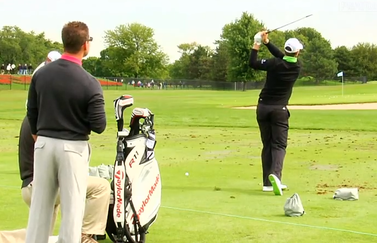 Over the last three years his putting has been average and that is an understatement. One thing does stand out though is that when his putting ranks in the top twenty for the week he normally finishes in the top five! So with that in mind his swing coach Sean Foley has got Justin to work with David Orr to improve his putting. Again like Rory McIlroy with his putting coach the focus has not to change his technique but to work and improve his pre-shot routines. At the PGA Tour Championship Rose was reported saying “You can make perfect strokes and not make putts. I know that I can putt well no matter what stroke I use is what I’m suggesting, when I get the right mindset”.  He must have had the right mindset as he finished 8th in strokes gained-putting and averaged 28.5 putts per round and ranked 3rd which resulted in a second place finish behind Brandt Snedeker. Now if he can harness that same mindset moving forward we could see a Major winner in the near future. David Milne and Lawrie Montague - Pro Tour Golf College  The great American amateur golfer Bob Jones said that when he was thinking of about three things during his swing he was playing poorly; but when he was thinking about two things he had a chance to shoot par; and when he was thinking of only one thing he figured he could win the tournament. Sometimes you really have to question whether the information circulating around the golfing world is helping or hindering the progress of golfers. Technology is a wonderful thing when it can be used to communicate something in a way that accelerates the progress of the golfer. However technology that slows progress is not a good technology regardless of how sophisticated it might seem.  When I was a young golf instructor I loved to get my hands on any technology that could help my students to grow and develop their game further - and I still do!. But what I have come to realize after many years helping golfers to learn and develop their game is that golf is still a stick and ball game that requires a fundamental understanding of how to move the golf club so that you can influence the golf ball to behave in a consistent and predictable way that ultimately leads to lower golf scores. "Golf is still a stick and ball game that requires a fundamental understanding of how to move the golf club so that you can influence the golf ball to behave in a consistent and predictable way that ultimately leads to lower golf scores." This hasn't changed about golf, and this is what I love about it. Golf can be as simple as you want it to be or as complex as you want it to be. The choice is entirely yours. When we work with golfers at Pro Tour Golf College we never forget that golf is essentially three things:
 Golfers are happier when they score lower and your approach to developing your golf skills should never lose sight of this fact. Yes you can slow golf swings down frame-by-frame and analyse in detail the micro moves of a golf motion, and you can compare your golf stroke to champion golfers. But does it lead to lower golf scores?... This is the one thing that hasn't changed about this game for more than five hundred years…it is still a game of score! So your mission is to find your way to developing a range of golf strokes that leads you to lower golf scores. I know that you already know this, but I’m not sure that you remember its importance when you’re not playing to your expectations. Get good at finding ways to lower your golf score by influencing your golf strokes to impact the golf ball so that the ball behavior leads to lower golf scores. It is as simple as it is complex. It is as easy as it is hard. It is golf. Lawrie Montague and David Milne - Pro Tour Golf College How to Practice Golf: How Good Does Your Wedge Game Have to Be to Play On a Professional Golf Tour?22/9/2012
 Golf is a game of score. I know I have said it before but it's true, and if you want to become a successful amateur or professional golfer you have to become a great wedge player and a great putter. Because there’s no point perfecting your putting stroke if you can’t hit your green-side and approach wedge shots close enough to the hole to give yourself a good chance of making the putt. So how close do you need to hit your green-side and approach wedge shots to make the putts? This is the key question in golf development from the point of view of producing a lower competitive score average. In today's article we will look at just how good you should aim to be if you want to compete successfully on a professional golf tour, or you want to become a leading amateur golfer. Using shot-link statistics from the PGA Tour we'll look at how good the best on the PGA Tour are when they face wedge shots from around the green and out to 100 yards.  Measuring Approach Wedge Proximity to Target We'll start with chip shots around the edge of the putting surface and work our way out from there, and we'll look at three statistics;
At Pro Tour Golf College we measure these statistics carefully and accurately because they will define how good you are with a wedge in your hand, and how good you can be.  Chip Shots From the Fringe The average distance a top ranked PGA tour player will hit his chip shots from the fringe is 2 to 3 feet from the hole. From this distance range they will make 95 to 99 percent of the putts they face which basically means that they don't miss very often from this distances close to the edge of the putting surface. If you're ranked in the top 50 for this statistic on the PGA Tour you will get the ball up and down 90 to 100 percent of the time.  Greenside Sand Shots Within 20 Yards of the Pin The average distance a top ranked PGA tour player will hit his sand shots from a greenside bunker is 7 to 9 feet from the hole. What this means is that from all types of sand and all types of lies and positions in a bunker they will hit their ball to within these distances of the hole most of the time. From this distance range (7 to 9 feet) they will make 43 to 56 percent of the putts they attempt. If you're ranked in the top 50 for this statistic on the PGA Tour you get the ball up and down between 57 and 73 percent of the time from within 20 yards of the pin. 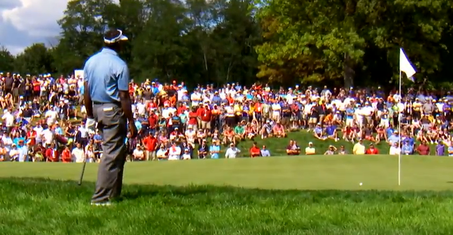 Greenside Trouble Shots From the Rough When a top ranked PGA Tour player misses a green in regulation and has to play from the rough within 30 yards of the green they are very good at getting the ball up and down. If you're ranked in the top 50 for this statistic you get the ball up and down more than 58 percent of the time. This means that top PGA pro's are as good out of trouble lies in the rough as they are playing out of bunkers. This is important to take notice of. Top golfers turn trouble shots into pars and birdies when they miss greens. The distance range a top ranked PGA tour player will hit his shot from the rough to the pin consistently is between 6 and 8 feet. Which means that from all types of lies and positions within 30 yards of the edge of the green in the rough they will hit their ball to within these distances of the hole most of the time. From the distance range (6 to 8 feet) they will make 49 to 65 percent of their putts.  Greenside Pitch Shots When a top 50 PGA Tour player misses a green in regulation and has to play a pitch from 20 to 30 yards to the pin they are very good at getting the ball up and down. If you're ranked in the top 50 for this statistic on the PGA Tour you get the ball up and down 55 to 65 percent of the time. The distance range a top ranked PGA tour player will hit his shot to the pin consistently is between 7 and 9 feet. What this means is from all types of lies and positions within 30 yards of the pin they will hit their ball to within these distances of the hole most of the time. From this distance range (7 to 9 feet) feet they will make 43 to 56 percent of their putts.  Approach Wedge Shots 50 to 75 Yards In this distance range a top ranked PGA tour player will hit his shot from 50 to 75 yards of the pin consistently between 6 and 12 feet from the pin. What this means is from all types of lies and positions from the fairway when 50 to 75 yards of the pin they will hit their ball to within these distances of the hole most of the time. From this distance range (6 to 12) feet they will make 30 to 65 percent of their putts. Of recent times Justin Rose has been the best in this category hitting his wedge shots on average 6 feet 11 inches from the hole.  Approach Wedge Shots 75 to 100 Yards In this distance range a top ranked PGA tour player will hit his shot 75 to 100 yards of the pin consistently between 12 and 16 feet from the pin on average. What this means is from all types of lies and positions from the fairway when within 100 yards of the pin they will hit their ball to within this distance range of the hole most of the time. From this distance range (12 to 16 feet) they will make 20 to 30 percent of their putts. Putts made % = Distance from Hole % There is a strong correlation between your proximity to the hole results of your greenside or approach wedge shots and how many putts you can make. We teach our students at Pro Tour Golf College to study their numbers closely and then go to work on improving their greenside and approach wedge skills because we know that hitting closer to the hole will give them their best chance of making more putts and ultimately producing a lower competitive score average. Do you practice measuring how far you hit your golf shots from the hole in any of your practice sessions? My question to you is how can you improve your greenside and approach wedge skills if you don't know what your average distance from the hole is? It is so much easier to generate improvement with your greenside and approach wedge skills if you can determine how far (on average) you hit your shots from the pin. Your normal statistics don't tell you this, which is a problem if you are motivated to get better and are spending a lot of time practicing your golf skills. Ask yourself this question; "what is more important, my scrambling percentage from a greenside bunker or what my average distance from the hole is from the sand?" Let's say that your scrambling average is 45 percent. In other words for every hundred greenside bunker shots you play 45 lead to a score of par or better. What this information doesn't reveal however is where your golf ball was on the green in relation to the pin.  What if your average distance from the hole was 7 feet. PGA Tour professionals make about 56 percent of their putts from this distance. Proximity to the hole statistics help you to more easily work out what you should spend more of your time working on. It is not difficult to do if you have someone you can work with. Basically you hit 10 golf shots at a time and mark with tees or ball markers where the ball comes to rest and then using a tape measure you determine the exact distance your ball is from the hole. Once you have hit the 10 golf shots and measured their distance from the hole, divide the total number by 10 to determine your average distance from the hole. Proximity to the hole is an underrated statistic which very few elite level amateur and professional golfers use to determine how good they really are with a wedge in their hand.
You should strongly consider adding it to your practice statistics so you can more effectively determine how good you are and more importantly how good you can be when you're hitting shots into the green out to 100 yards. Lawrie Montague and David Milne - Pro Tour Golf College Golf On Tour: Rick Smith Verses Butch Harmon Who Has the Better Record with Phil Mickelson?22/9/2012
Leading into the Tour Championship the final tournament of the FedEx playoffs the top 5 players have their destiny in their own hands. This means that if they win they will win the FedEx Cup and the bonus US$10 million PLUS the winner’s cheque on offer for the Tour Championship.  The East Lakes Golf Club which is the oldest golf club in Atlanta (founded in 1898) and was the home club of the legend Bobby Jones. It is a great test of golf for the final thirty golfers who have made it through the playoffs. In fact the winner will also be presented with a replica of Jones’s famous putter “Calamity Jane” which he used to win thirteen Majors and the Grand Slam (US Open, US Amateur, British Open and British Amateur) in 1930. The putter has 8 degrees of loft compared to modern day putters which have less than 4 degrees of loft.  So who are the favourites after Rory and Tiger the obvious choices at #1 and #2 in the points? With East Lake being a long course and with rain softening the course recently and fast greens the longer hitters who can also handle the flat stick will have the advantage. One name jumps out and it’s Phil Mickelson who is currently 4th in the FedEx points, bombs it off the tee and is ranked 5th in strokes gained-putting. His recent form also suggests he is peaking after a T38th in the Barclay’s, T4th at the Deutsche Bank and T2nd at the BMW. 'Lefty' also won at East Lake in 2009 and all the signs are pointing to the most competitive final tournament of the playoffs since its inception in 2007. Mickelson has been an exciting golfer that galleries love watching as he plays aggressively and has recovery skills that are second to none. 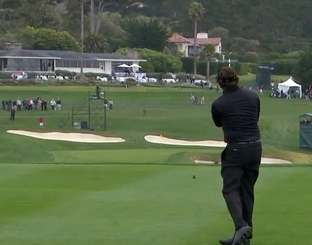 It is this cavalier style that won him the US Amateur title in 1990, and at the age of 20 in 1991 whilst still an amateur he won the Northern Telecom Open on the PGA Tour, the last to achieve this incredible feat. In his early pro career Mickelson worked with swing coach Rick Smith and also short game guru Dave Pelz. In 2007 after the Masters he announced he was changing swing coaches and Butch Harmon became his swing instructor. In 2009 Dave Stockton took over the reins from Pelz officially coaching Mickelson with his putting and short game. Now I have observed Mickelson's swing and performances before and after the changes with the coaches he has worked with and I have not seen any changes in his full swing technique. But as we know at Pro Tour Golf College golf performance on the golf course is the true indicator. So I have crunched his statistics in the categories of;
The results are interesting and revealing... Under the guidance of Rick Smith, Mickelson was 6.59% more accurate off the tee, hit 2.65% more greens in regulation, won 3 Majors against 1, and had one more tournament win. Under Butch Harmon, Mickelson earned an average of $313,922.00 more per year mainly because 2003 was his worst year winning $1,623,137.00 which was way down on his average earnings per year, and it was the only year he did not win a tournament.  This year is the 1st year he is ranked better then 40th (he's ranked 5th) in strokes gained-putting and it’s since he has adopted the “claw” grip which proves that golfers especially those who make a living on playing for a living will do whatever it takes to score low. And if changing the coach is perceived as the solution so be it. Although in Mickelson’s case the statistics don’t support it. Conclusion; Phil Mickelson is a very successful modern day professional golfer who gets the job done no matter who is coaching him. David Milne and Lawrie Montague - Pro Tour Golf College  When you go to the practice fairway or driving range to work on your game what do you do work on and why? Do you work mostly on your golf swing mechanics, or do you work on controlling ball flight, or both? These are important questions if you want to improve your golf scores and become more consistent in golf tournaments. If you could just concentrate on one thing what would it be? What is the message that you will send to the muscles that move your golf club? For many golfers, the messages sent to their muscles are mixed and many and this undoubtedly leads to confusion, frustration and inevitably poor golf shots. You can make incredible progress with your golf swing if you can decide what it is you want it to do. If you start with the thought of what the goal of your golf swing is before you go to work on it. In other words you begin with the end goal in mind. Here’s a huge mistake made by many golfers though. They assume that if their golf swing looks like x it will perform like y. But how your golf swing looks and how your golf swing functions are mutually exclusive. In other words, how it looks and how it works isn’t necessarily the same thing. Swing style and swing function are different. Many golfers fall for the trap of building a golf swing that looks like a certain tour professionals only to discover it doesn’t work nearly as good. No two golf swings are the same. There are similarities but they are all different. Therefore style is not nearly as important as function is. There are many styles of golf swings but not as many functional differences. A golf swing serves a purpose and that purpose is to hit a golf ball correctly. So what is the goal of your golf swing?...  At Pro Tour Golf College we explain to our students that their golf swing has a responsibility to achieve just three objectives to be a top level amateur or tour player and they need to know what they are, and then learn to achieve them. So let’s start with an important but essentially simple presupposition; the purpose of the golf swing is to produce a correct and consistent impact so you can achieve these three objectives. And the style of your golf swing is to move your body and golf club in such a way that the outcome is that you achieve a golf shot that meets these three objectives. The Three Golf Swing Objectives All golf swings are different in style but the good ones produce consistently solid shots out of the sweet spot of the clubface with superb control over the amount of spin they produce. 1. Solid Contact Mastery For the ball to travel the distance you require you have to hit the ball out of the sweet spot which is also called the centre of percussion. Golf at the highest level is a game of control over distance more than accuracy. You need to develop your golf swing so that it hits a high percentage of shots solidly out of the clubface so your shots finish as close to the pin as possible. Tour players are experts at controlling the distance they can hit their golf shots (particularly the short irons) to within close proximity of the hole or target. One of the goals of your golf swing should be to develop your technique so that there is a high likelihood that your golf shot is hit out of the sweet spot. This means that your golf swing must function so that you can achieve this goal. If you hit more shots away from the sweet-spot of your clubface then you need to talk to your golf teacher about this and develop a strategy that changes this situation. It has been our experience that the single biggest error made by advanced amateur golfers is their inability to control the distance of their golf shots into a green. We estimate that as much as 70 percent of their golf shots finish well short of the pin. This first of the three objectives is critical to your golf swing development, and what is amazing is that it is one of the easiest to measure. A couple of pieces of electrical tape stuck to the face of your iron or wood will give you instant feedback and show you what percentage of shots you hit out of the sweet-spot. 2. Shot-Making Corridor Mastery Many of the golf courses that you will play as a competitive amateur or professional golfer require an ability to start your golf ball on the line of the clubface. What this means is the golf ball can fly straight off the clubface towards your intended target. The purpose of your golf swing is to produce a high percentage of shots that can travel in what we call the shot-making corridor. The corridor is an imaginary rectangular window that extends upwards from the target line. The objective of your golf swing is to hit a high percentage of your golf shots down your chosen target line, solidly hit with minimal curvature. When you hit longer shots with your driver, three wood or hybrid clubs it is essential that you have the ability to start the ball on the correct path so that you can hit your long shots closer to your intended target to set-up your next shot. Tour golf courses are designed for the strategic placement of golf shots and they reward those who can control the direction of their shots better than others. If you can start and keep your ball on the target line you've chosen then you can hit your shots into areas of the fairway where you are rewarded with better angles into the tough to get to places on the green. 3. Minimal and Maximal Curvature Mastery The third objective of your golf swing is to control spin or curvature. When you swing your golf club you need to control the amount of sidespin and backspin you produce on your golf ball if you’re to become a competitive amateur or professional golfer. To be able to control sidespin is the trademark of a top class golfer especially in this age of technology where the golf ball and driver is designed to hit the golf ball very straight. Old school golfers learnt to curve their golf ball as part of their playing development, but today few young amateur and professional golfers can curve the ball with control. Tiger Woods is one golfer who values old school ideals and is exceptional at controlling the amount of curvature on his shots from the tee and also into the greens. Golf is played with a spinning ball and as such your ability to either produce excessive curvature or minimal curvature when needed is a prerequisite for developing your golfing abilities further.  Whether you’re hitting a wedge into the green or a driver from the teeing ground you need to control spin and your golf swings purpose is to develop this important function. When you practice hitting golf shots on the range you should be practicing the fades and draws as well as the straight shots. And when you're practicing your short-game skills you should be practicing controlling the spin on your wedges so you can stop them faster and also make them run on. We rarely if ever see this, particularly with younger golfers who seem to be under the impression that the top tour players hit straight golf shots all the time. They don’t; top tour golfers can hit the ball with fade or draw quite easily, and they need to because many of the courses they play require the ability to hit a shape to their tee shot to position themselves for their next shot. When you’re hitting wedge shots into the green can you control the spin so that some of your wedges stop quickly whilst others release towards the pin? The one dimensional golfer practices the straight shot most of the time and doesn’t work on spin control with their wedges. Believe me when I tell you that you will get found out when it matters to you most! It is a disadvantage to hit it straight when golf courses are designed with doglegs. It is a disadvantage to hit excessively spinning wedges to a soft green; and it is a disadvantage to produce too little spin on your wedges when you’re hitting to a firm green. Learn how to hit fades and draw shots as much as you work on your straight shots, and learn how to control the amount of backspin on your wedges, and you’re well on your way to developing the second objective of your golf swing, mastering the spin on your golf ball. Your golf swing serves one purpose and it cannot serve two masters. The ultimate aim of your golf swing is to produce a consistent and correct impact with the golf ball. We live in an age where it is very easy to lose sight of this important goal and instead get caught up in the analysis of swing style at the expense of building a reliable golf swing technique. The litmus test of your golf swing is whether you can control the flight and behavior of your golf ball and the best way to do this is to measure your shot-making ability. So how do you measure the quality of the three golf swing objectives when you practice or play? At Pro Tour Golf College our students measure every golf shot they hit and one of our training drills is built around practicing the three objectives and measuring the results using the 'Shot Making Quality Scorecard.' You can see in the picture above that Sam hit 30 golf shots (Straight shot, fade shot and draw shot) and we measured contact, start-line and spin. One point was awarded for achieving each of these objectives and after 10 shots we add them up to see how he fared.
This is just one way we measure student performance at Pro Tour Golf College because without an ability to measure your results you can't manage and improve them. The golf swing style is important, but only if it can meet the three objectives. If your golf swing technique is not doing this, then you’re off-track and you need to get back to basics and work out why you can’t hit the ball where the clubface is pointing most of the time. The pathway to building the perfect looking golf swings is very popular today with high speed video cameras and computer programs to break down every part of your swing down. But this can lead you along way down the pathway of disappointment. The fundamentals of this great game haven’t changed, but they have been pushed aside in favour of the perfect looking golf swing. The best golf swing is the one that can control the three objectives most of the time. This is the purpose of your golf swing. Get this right and you can develop your golf game to the highest levels in amateur or professional golf; get it wrong and you will never become the golfer you want to become. It is that simple. The choice is yours. Lawrie Montague and David Milne - Pro Tour Golf College Golf On Tour: How Rory McIlroy Improved His Putting to Become a Prolific Winner on the PGA Tour15/9/2012
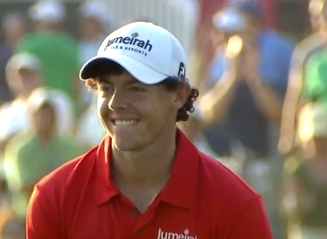 Rory McIlroy before the Masters 2011 was already a winner on the PGA Tour winning the Wells Fargo tournament in 2010. Now since then he has won another five times including two Majors! So what has changed in his game to allow this to happen? His ball striking has not changed much but his putting stats have. Looking at his stroke gained –putting stats from 2009 compared to the field average you will see a steady improvement each year and a big improvement in 2012. 2009 Minus .335...............150th in ranking 2010 Minus .225...............145th in ranking 2011 Minus .129...............130th in ranking 2012 Plus .098.................76th in ranking  In his own words describing the Stroke Gained – Putting stat; “finally a putting stat that has relevance to how well you putt.” Also Shot Link stats show what averages and ranking Rory achieves at varying distance. I’m sure these stats will surprise a lot of you golfers out there! Putting from 5 feet.....................96.68% Rank 59th Putting from 5ft – 10ft.................59.03% Rank 41st Putting from 10ft – 15ft...............33.33% Rank 39th Putting from 15ft – 20ft...............21.92% Rank 26th Putting from 20ft – 25ft...............11.63% Rank 89th As you can see from the above numbers every five feet the average reduces by nearly half. That’s the reason all targets at PTGC from short game to approach wedges the targets are set 6 feet or smaller. So we now know that his putting keeps improving but what has contributed to allow this to happen especially when we observed his game and in particular his putting during the 2011 Masters go into meltdown (he shot 80) after leading going into the last round. Step in Dave Stockton to work with Rory soon after the 2011 Masters. Stockton a two time Major winner PGA Championship himself (1970/76) and winning Ryder Cup captain in 1991 had a reputation of being consistently one of the best putters when he competed on the PGA Tour in the 60’s and 70’s and the Champions tour in the 90’s. After his first session with Rory, Stockton analysis was that Rory’s putting mechanics were flawless but assessed that his focus was on technique. Rory’s comment after that first session was “Everything Dave said was the opposite of what I’ve been told before.” “People often said to me that I was too quick on the greens”. Stockton on the other hand wanted Rory to get more flow into his routine. To achieve this, out went Rory’s three practice swings, and all Stockton wants Rory to do is “See the target where you want to hit it, and just go with it." This allows him to be more natural and not get in his own way, especially when it counts under pressure.  I have done a comparison of Rory’s average putts for the first four stroke play tournaments of 2012 where he averaged 28.5 putts per round and had 1 Win, 2 Seconds and 1 Tied 40th. And when he missed cuts in the Players, Memorial and US Open where he averaged 30.125 per round compared to the last four where he has averaged 27.7 putts per round for 3 Wins and a T24th. So a very telling fact that when the top players average around 28 putts per round they are usually in contention to win and when they average over 30 putts per round they struggle to make cuts. In conclusion, it might not be your putting technique holding you back from making more putts but a pre putt routine (PPR) that does not suit you. Once you have identified the PPR that works for you, the next stage is to put it under pressure and test that you’re sticking to it. David Milne and Lawrie Montague - Pro Tour Golf College  How long does it take to change a golf stroke habit? The answer is that it depends on the complexity of the change you are undertaking and the amount of time you invest in developing it. I think most golfers know that. Your way of life is a product of all the different habits you have developed knowingly and unknowingly over your life time. In the case of changing golf stroke habits it can take a long time. And here's why? The simplest way to explain it is that you have 13 major joints in your body moving in three dimensions plus the timing required to move them at the correct time and you are required to propel a golf club around your body inside of two seconds and strike a stationary sphere in such a way that the result is a solidly struck golf shot that travels to your target more often than not. I bet you thought that it was a lot simpler than that? “Swing it back and through,” “turn your body back and swing your arms through” etc. Now when you see the top professionals hitting shot after shot down the fairway and onto the green making it look easy you’ll realise that it far from easy. However even a complex activity like a golf swing can look easy when it is mastered. Today we’re seeing a lot of golf books coming out that are marketed to average amateur golfers suggesting that changing your golf swing is something that is relatively easy to learn and do. This partly explains the wide performance gap between amateur golfers and professional golfers. Amateur golfers are being exposed to information that is technically not correct. Many golf instructors know this first hand as they have had the experience of a golfer they’re teaching expecting their golf swing to perform optimally in a club competition the very next day after just 45 minutes on the lesson tee. Golf instructors are good but not that good. I have personally known of golfers to fly to the other side of the world to have a golf lesson or two with a well known golf instructor, and after paying a significant sum of money for the golf lesson they find out that the change that has been suggested will take months to improve!  The expectations of golfers of all levels (amateurs to professionals) can be a long way from the reality of what’s really required to successfully change an aspect of your golf swing technique. The truth is that if you’re changing a feature of your golf swing technique or in-fact learning a new part, it will take time to habituate through carefully applied effort. This is worth remembering. You simply cannot buy a faster golf stroke learning process.  The electrical impulses you’re sending from your brain to a new set of muscles (or even the same set) to fire the muscle differently requires thousands of repetitions to strengthen the neural pathway so that the signal is stronger, more efficient and ultimately habit forming. Let me say it again... "You simply cannot buy a faster golf stroke learning process."  The Golf Swing Complexity Model At Pro Tour Golf College we work with our students to help them to understand the golf swing change process and the way we explain it is that golf swing change process falls into five categories that describe the complexity of the skill set and the amount of time that it is likely to take to become a habit. The complexity of the skill set in our model describes the amount of joints recruited for the particular golf stroke and the amount of rotation. A putting skill requires the fewest joints and minimal rotations whereas the full swing technique recruits the most joints and rotations. 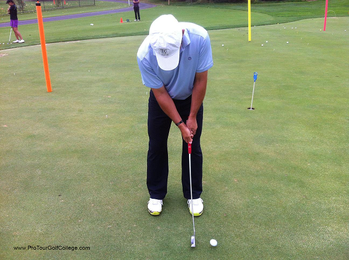 Complexity Level 1. (2 to 4 Weeks of Practice)
Very small golf swings that swing no higher than your ankles (like the putting stroke) fall into this category. To change to way your putter behaves at this level means you are reducing the amount of rotations to shoulders rotating around the upper part of your spine. With reduced complexity at this level you will develop a new stroke habit relatively quickly.  Complexity Level 2. (4 to 6 Weeks of Practice)
Level 2 strokes describe golf strokes where the golf club-head travels no higher than your knees. So this would include all chip shots and chip and run shots. With this stroke very little wrist to no wrist angles are used and shoulder and hip rotation is kept to a minimum which keeps the complexity down and makes it easier to habituate a change.  Complexity Level 3. (6 to 8 Weeks of Practice)
Level 3 strokes describe a stroke where your hands travel to height of your waist and the golf club to the height of your ear. This stroke is employed when you hit your pitch shots around the green. The upper body is starting to rotate to about half of its final position. 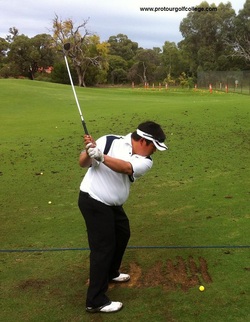 Complexity Level 4. (8 to 10 Weeks of Practice)
Level 4 strokes describe a stroke where your hands travel to height of your shoulder and the golf club above your rear shoulder. This stroke is employed when you hit your approach wedges into the green, greenside sand and trouble shots and many other types of approach shots. This stroke is also the full stroke for many golfers who may not have the flexibility or body type to swing their arms and hands higher than their shoulders with control. The upper body is starting to rotate to its final resting position and the hips are rotating almost fully.  Complexity Level 5. (10 to 12 Weeks of Practice)
The Level 5 stroke is the most complex stroke to learn and adjust because power generation is at its highest so timing of each element within the stroke is crucial. Level 5 strokes are full shots like tee-shots and hybrid shots into the green. This stroke describes an action where your hands travel higher than your shoulders and the golf club high above your rear shoulder. The upper body has rotated to its completion as have the hips, and the lead hand wrist has hinged fully as well as the rear elbow. 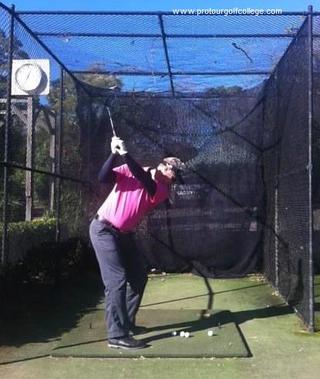 Golf stroke improvement is a function of deliberate effort minus distraction multiplied by time. To change the way a particular part of your golf stroke behaves under pressure requires a total commitment to practicing correctly. This means that you should practice without the distraction of ball-flight so that you can concentrate fully on translating the concept of the change into a recognizable 'feel.' You need to decide what level of complexity your stroke improvement falls into based on our complexity model and then plan your practice so that a higher volume of the work you perform is dedicated to changing the stroke. The graph below shows an aspect of how we plan a golf stroke change for a student at Pro Tour Golf College. It shows a micro-cycle of 7 days and the amount of balls hit each day with a target and without. The very best way to change a golf swing component is to eliminate the biggest distraction to every golfer - the target. By practicing hitting golf shots into a net you eliminate ball-flight and can get on with the job of habituating the proposed change to your golf stroke technique. We have found that the distraction of the ball-flight in making changes to your golf swing could add as much as 50 to even 100 percent more time to the actual change depending on the complexity level. Changing a golf stroke so that it functions differently is not an easy task for anyone, however by planning your approach carefully and also acknowledging the time required to fully habituate the stroke so that you can perform it under pressure you should be able to make the change faster than any other way.
The best of luck with your golf stroke changes and if you have any questions about my article please feel free to drop me a line. Lawrie Montague and David Milne - Pro Tour Golf College  After the first round of the Fed Ex Cup Deutsche Bank tournament the leader was South Korea’s Noh Seung-Yul with a 62. Seven shots back was Adam Scott who shot 69. The difference was Noh had 26 putts and Adam 34 putts and it didn’t get much better for Adam over the next two rounds. After three rounds Adam was twelve shots back of leader Louis Oosthuizen but led the field in ball striking, 3rd in field for driving distance and greens in regulation and 5th in driving accuracy and proximity to hole. At the other end he was last in total putts and 61st out of 78 in strokes gained-putting. Even for an experienced tour pro like Adam it would be easy to get despondent and let the putting stats ruin his week. So how did Adam go about handling the situation? After the first round he went on record saying that he was not able to block off negative thoughts on the green. He followed that statement by saying that there is nothing wrong technically with his stroke but was not matching the speed to the lines he picked for his putts. He finished his interview with “I have to let the missed putts go and not let it sit in my memory”. This is a champion golfers ATTITUDE that you can learn from so that after a bad round you can ensure you don’t erode your confidence by negative self talk linking to a bad attitude.  At the end of the third round at the post round interview and asked about his bad putting (reporters love highlighting weaknesses), Adam responded with “The putts will start to drop tomorrow if I maintain the feel I got going today. I need to eek out a top ten which would be a good week’s work when you’re not in contention”. Well chosen words and it set him up for a good finish. Adam shot 66 in the last round and finished tied 7th. Mission accomplished! The right attitude was his 15th club in the bag last week and now has created the necessary momentum leading into the last two tournaments of the FedEx Cup. 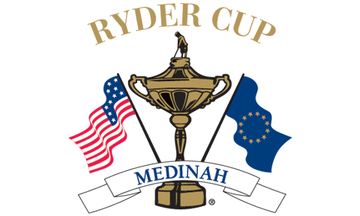 With the Ryder Cup around the corner USA Captain Davis Love has selected not only a team of in-form golfers but also the best putting team in the last decade to represent Team USA. As a team they collectively average 4.021 strokes in the PGA Tour Strokes Gained-Putting stat. Compared to previous Ryder Cup teams as shown below. 2010 ----- 2.728 2008------ 2.726 2006------ 3.045 2004------ 2.126 So if the USA team putt to their potential they will be very hard to beat on home ground. Medinah Country Club will host the Ryder Cup in 2012, its first time in the state of Illinois, and the first U.S. venue outside the eastern time zone since 1971. The competition is scheduled for September 28-30 on Course 3. As with Rory Mcllroy’s win last week when you putt well it sets you up to be in contention to win tournaments. Rory was No.1 in putts per round (average 25.8), putts per green in regulation (1.521) and No.2 in Strokes Gained-Putting (1.670). These stats combined with No.5 ranked in ball striking adds up to him making 25 birdies for the week. On the subject of putting Phil Mickelson has gone to the claw/saw putting grip last week at the Deutsche Bank tournament and he ranked 6th in strokes gained-putting for a 4th place finish. Next week in the Low score newsletter I will show you how you can train to putt like a tour pro. David Milne and Lawrie Montague - Pro Tour Golf College Our Next Semester Begins October 8th So Why Not Join
|
Archives
June 2019
|
Proudly Supported By
Copyright © 2011 - 2018 Pro Tour Golf College
Website Managed By Golf Performance Media
All Rights Reserved
Website Managed By Golf Performance Media
All Rights Reserved




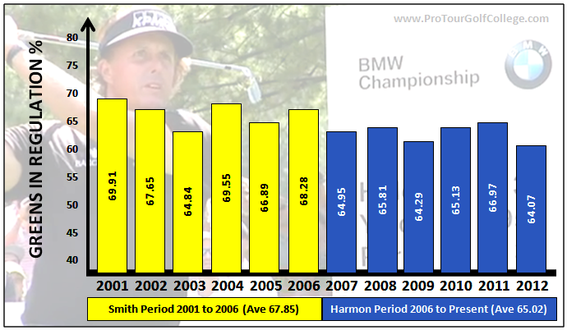

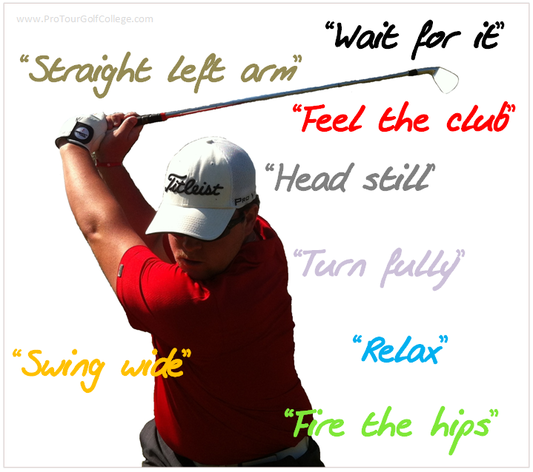



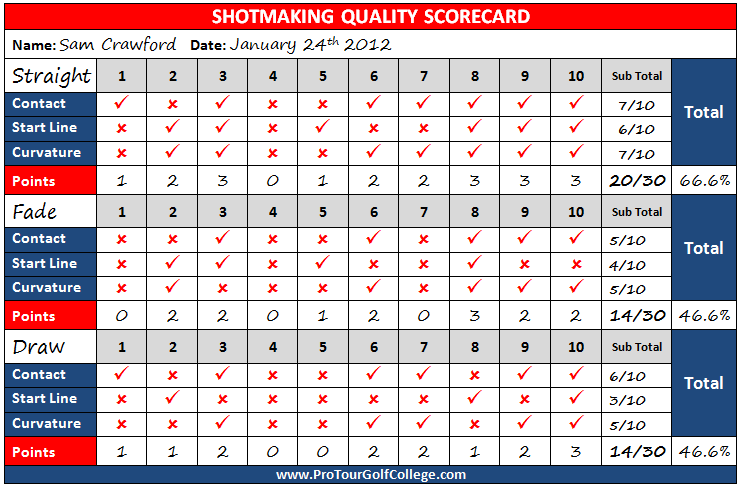





 RSS Feed
RSS Feed



